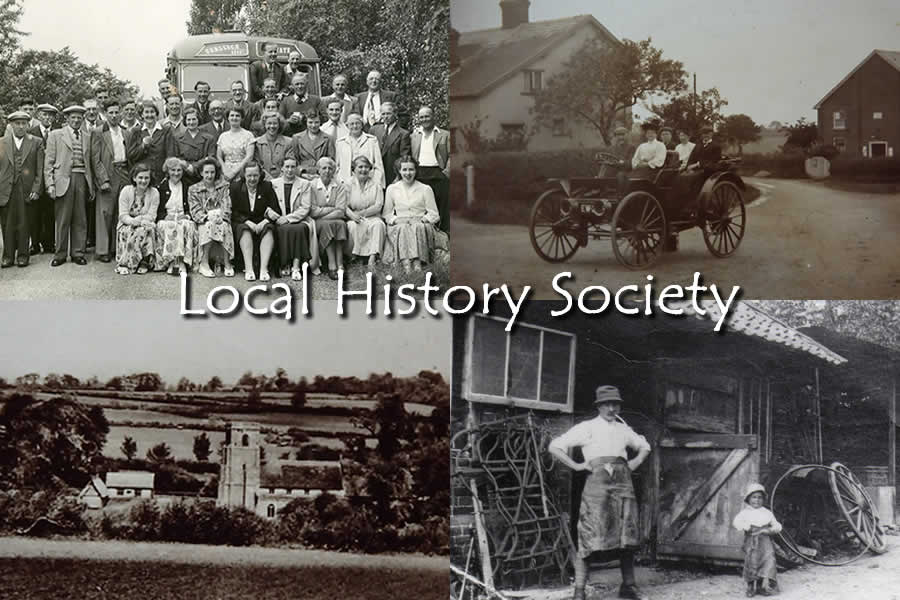On a sunny September day, over twenty members of SLHC made their way to Wickhambrook in the west of the county. The Focus On Day was being hosted by the local history society and tea and home made biscuits were ready for us in the WI Hall. The hall had been a WWI army hut before the WI took it over in 1926. Dr Margaret Thomas began by thanking Dorothy Anderson and her team for such a warm welcome and for giving us what turned out to be a third opportunity to visit this fascinating village, starting as an Anglo-Saxon settlement by a brook and evolving into the present day Wickhambrook, with its eleven greens and one-time seven mills plus many interesting buildings.
Dorothy proceeded to describe some of the history and character of the place. We got the impression from the society members that they all thought it a very special place to live with a very supportive community. The village sign has a woven heart attached to it. During the Covid lockdown, the woman who makes these hearts would quietly deliver them to peoples’ houses as a message of support during those difficult times.
Although ‘ten miles from anywhere’, Wickhambrook still has a very thriving village stores, which also comprises a post office and a petrol station! There is a church and a chapel and even a pub. Next to the WI Hall is a Memorial Hall and nearby is a primary school. Behind the two halls is a six-acre recreational ground. George Crabbe, the poet, is associated with the village. Another interesting character, Mrs Ann Marrow, lived at Pound House, and, between the years of 1851 and 1870, worked as a plumber and glazier but had an unfortunate death due to lead poisoning.
In two groups we were guided around the village to see some of the buildings. We viewed the local primary school built in 1878. No-one would give a piece of land until, as local legend has it, the owners of a cottage, which stood on the present school site, offered the land as long as their cottage could be moved a little way away as part of the deal. This is now known as School Cottage. The school’s claim to fame is that King George V had taken tea at the school in 1912 when inspecting the troops in Newmarket.
We heard the story of the ghost, which sat in the bar of the 17th century beerhouse called The Cloak. The ex-pub’s name is unusual and almost unique. Was it referencing the wool trade in the area as does the quirky name of a local road, The Duddery, a place where wool was treated and made into clothes -‘duds’ being clothes and maybe giving rise to the term ‘dude’?
Two local residents kindly allowed us onto their premises. The first was Commerce House, where we had a closer look at the outside of the house from the gardens. A fascinating building, three stories high and thatched, it was built in 1480. In 1720 the house was ‘Georgianised’ by James Gibb, who also built the Corn Exchange in Bury. The name refers to the fact it was a grocer’s shop from the 1800s. Described as the ‘Fortnums’ of Suffolk’, it belonged to the Woollard family and was a shop for 110 years until 1972. The family lived at the house cum shop and the building is the oldest inhabited and the tallest thatched house in Suffolk.
At the second house, Brook Cottage, we were treated to a tour inside by the owner. A Suffolk thatched cottage, originally a long house and, as the name suggests, next to the brook. In 2006 it eventually had electricity. When it was renovated in the 1970s many prescription books were discovered belonging to a Dr Stutter who had occupied the house in the Victorian era. Apparently, laudanum was a common theme. Another renovation revealed copies of newspapers carrying stories of the Boer War behind the wallpaper. The original well is still present inside the building.
The Parish Church of All Saints was open for us to visit at lunchtime and Dr Paul Bevan, churchwarden, was there to guide us around this lovely church with its many brasses, one of which still has the traces of its coloured enamel, and its beautiful hammerbeam roof. The building grew from a Saxon chapel.
The other place of worship in the village is the Methodist Chapel. We were welcomed into this restful space by Cecelia Hawley and given a very interesting talk on its history. This chapel bears the inscription Primitive Methodist Chapel 1850 Ebenezer. The Primitive Methodists differed from other Methodists in that they originally spoke to the people, often agricultural workers, in the open air, as did this chapel’s founder Billy Durrant. The size of the pulpit indicates it is a Primitive Methodist chapel as there is room for three or four preachers to speak.
The day ended in the traditional way with tea and delicious homemade cakes back at the WI Hall. SLHC’s thanks go to Dorothy and all the people, who worked so hard to give us another very enjoyable and informative day in Wickhambrook.
Lynne Ward
